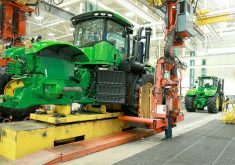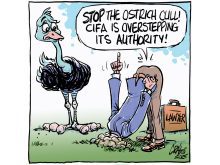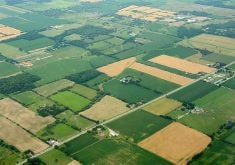Rolf Penner, a farmer from Morris, Man., and the Manitoba vice-president of the Western Canadian Wheat Growers Association, calls the federal government to action.
It’s clear-cut. The federal Conservatives finally have the legal ability to make good on their long-held election promise to break the Canadian Wheat Board’s marketing monopoly over western wheat and barley.
The question now is, do the Tories really want to keep that promise?
In January, the Supreme Court of Canada announced that it would not hear a final appeal by the CWB of the 2006 so-called “gag order” case. That confirms a unanimous appeal court decision last year, which made it clear that the federal government is in control and has the power to direct the CWB over the “full range of activity which the Act authorizes the wheat board to conduct.”
Read Also

Budget seen as fairly solid, but worrying cracks appear
The reaction from the agriculture industry to prime minister Mark Carney’s first budget handed down November 4th has been largely positive.
The appeal court completely blew out of the water one of the board’s key arguments, that 1998 changes to the Wheat Board Act, made by then Liberal agriculture minister Ralph Goodale, put the board’s directors in charge of the agency.
The amendments gave farmers an increased role over day-to-day operations, the court agreed. But the revisions not only preserved Ottawa’s control, they actually strengthened it, with directors duty-bound to comply with any orders issued by Ottawa.
That puts agriculture minister Gerry Ritz in the CWB driver’s seat if he chooses to be there. He does not have to engage in a painful parliamentary contest to change the immediate rules of the game.
CWB chair Larry Hill took issue with the courts, arguing the sweeping changes to the CWB Act in 1998 were intended to pass control to farmers.
“When the government overrides the CWB board of directors,” Hill huffed, “it is overriding the democratic will of farmers.”
Unfortunately for Hill, his moral authority is even less than that of his legal authority. If the wheat board were a voluntary, non-government organization, he might have a point.
It also doesn’t help him that the CWB’s own annual producer survey continually shows that most farmers want the board to be either voluntary, or done away with completely.
Or that the 2007 barley plebiscite showed that 62 percent of barley producers no longer support the CWB monopoly on barley.
Ultimately, legislative changes will have to be made to the Wheat Board Act to guarantee western farmers marketing freedom and that’s unlikely in the current minority situation.
Nonetheless, given the appeal court ruling, the Conservatives have the capacity to give farmers more choice and more control over their own farms.
Once farmers get a taste of marketing freedom, it will be difficult for any future government to turn back the clock.
The Tories have options. They could order the CWB to give export licences to western farmers on the same basis it gives them to eastern farmers, without having to first buy back their own grain.
For practical purposes, this would make the board voluntary.
An incremental option would be to provide an exemption from the monopoly for the export of wheat and barley varieties that are now sold for feed or go to ethanol plants.
Or how about allowing domestic grain processors and maltsters to buy directly from farmers?
What about permitting individual farmers to buy back just a small amount of their own grain, say 200 tonnes, at the low price now enjoyed by western organic producers?
These are the types of exemptions the board of directors has authorized in the past and can in the future as well.
Given that the courts have found that the feds have more power than the directors, there is no reason why they can’t authorize these or any number of other exemptions.
It’s hard to see how the Liberals could convincingly object to the Conservatives using the same power to direct wheat board activities that they themselves increased little more than a decade ago.
It is wrong of any government to force farmers to hand over their property, their grain, to others. It is galling when the federal law that makes this possible is used to discriminate against farmers based on where they live or their production practices.
The Conservatives have a strong argument for making the CWB voluntary and they now have the authority to do something about this ongoing injustice.
It’s time for them to act, and to give farmers more freedom to sell their grain to whomever they choose.
Re: “Farmers struggle with trespass law” (WP, April 1.) Trying to come up with a trespass law is simple. The onus must be put on the trespassing person(s) as their responsibility to make sure that they are on crown/public land and not on private land. If you are not on your property, then you are on someone else’s property.
It is unreasonable to expect landowners to fence or post their property, at great expense, to keep out trespassers. Perhaps it’s the crown/public lands that should be posted.
If trying to talk to trespassers doesn’t succeed, land owners could consider filing property and punitive damages against the trespassers by having identity, video, photo and vehicle description.
As a result of the NDP premier’s out-of-control spending habit, producers in Manitoba’s supply-managed industries are being punished with a new “food tax.”
The $535 million deficit budget contains a new levy on the exchange/transfer of the value of quotas, a first-of-its-kind measure.
In making this decision, the NDP did not first consult with supply-managed producers and how it will impact their industry. This is troublesome because producers will receive absolutely nothing from it – no added services from the government, no additional benefits and no additional government support whatsoever.
This measure will have a terrible impact on farm families who produce high quality food for Manitobans. The ability to buy and sell quota is an important management tool for producers in the supply managed sector.
Instead of supporting these hard-working individuals, Greg Selinger is taking from them. His NDP government has decided to tax these transactions for the sole purpose of bringing more money into the NDP’s coffers.
Selinger has refused to provide specific details about the tax, such as what level it will be set at, which commodities are involved and whether it will be raised in the future. He has also refused to acknowledge the impact this new tax could have on Manitobans’ food prices.
We suspect if the cost to producers goes up, they will have no choice but to pass on some or all of that cost to consumers.
Bottom line: Manitobans, especially farm families, shouldn’t be forced to suffer financially because Selinger can’t balance his own books.
Re: Seed Hawk and Seed Master seeders, there are claims that these machines can seed into tall stubble. They were tested in areas like Swift Current, where the ground is dry and there is low humidity, but go to tall stubble in the northeastern Saskatchewan, where the ground has much moisture and high humidity, tall stubble plugs the shanks and piles of stubble of which I have seen the worst mess of seeding from Kamsack to Regina and Melfort.
In direct seeding during combining, the stubble needs to be cut short and the straw chopped fine. After combining, the stubble should be harrowed with heavy harrows and again in spring before seeding to dry the soil to proper moisture and avoid plug up in the shank assembly for even seeding and proper germination of grain.
When the ground is covered by tall stubble and straw, it does not let the sun dry the ground and when the ground is too wet, it stays cold and the seed does not germinate properly.
For some weeds the stubble needs to be worked in fall.
Weeds are becoming chemical resistant and what will happen in years to come?
Sometimes farmers are their own biggest enemy, listening to people with university education telling farmers how to farm (not realizing) how little they understand. Put them to farm and see how long they will last farming.
When the BSE crisis began, all livestock auction businesses were shut down for three months. When it was determined that most likely none of the disease entered the food chain, auction, livestock facilities started buying. Cattle prices went to rock bottom.
Many thousands of livestock owners took a real back lashing. It was not their fault. The industry shook the consumers’ nerves. Many people stopped buying beef from the store shelves because they were scared that beef products were unsafe to eat. Farmers’ livelihoods were being shattered because most farmers depend on accessing revenue by selling livestock to be able to pay farm expenses.
I lost lots of money, took a big loss when I needed operating capital for my mixed-farming operation. I was in a stressful situation because I did not have an operating loan from any financial bank system, because one should not have to have an operating loan to run a farming operation. …
The governments, provincial and federal, did not compensate livestock owners for their losses because of the BSE crisis. I want them to compensate all livestock owners for their terrible losses because many types of livestock sold for as low as one cent per pound, where as the going price for beef is $1.15 per lb. …
Re: “Watershed protection a vital need,” (Opinion, April 15.) Mr. Obad, interim director for Water Matters, should be commended for his article supporting Alberta’s dwindling and under-recognized fresh water resource.
Water Matters and their staff are an amazing collection of genuine and proactive water experts who dare to question the narrow and shortsighted focus of the takings of fresh water for giant industries and squandered use.
It would seem we Albertans have no future vision outside of a three to five year window of so-called economic opportunity, nor do we as a society in Alberta want to understand the links to life dependency that a healthy functioning watershed is critically dependent upon.
In Alberta, it is apparent that big industry (money) is the deity Albertans are forced (or want) to worship above all else, including the health and quality of life of their grandchildren.
When will sustainable local food production, clean drinking water and healthy aquatic ecosystems be elevated to the same pedestal of importance?
Thank you, Mr. Obad and Water Matters. Such courage is remarkable and rare.
I was recently (April 12) watching the 6 p.m. news on Radio-Canada’s French television network. A report claimed that Saskatchewan is the highest per capita consumer of energy in Canada. I’m not sure if the English CBC aired the same report, as is often the case on the evening news from Regina.
I think there are a few journalists who need to go back to school. How can they overlook the fact that most of the fuels that are used for agriculture here in Saskatchewan, especially during the planting and harvest seasons, are used for the production of food that will be delivered to the four corners of the world?
Add to that, the energy that is used to produce oil and petroleum products that are destined for the U.S.
One must also take into account the energy used in the manufacture of agricultural and other equipment. For example, the energy that is used to build and transport an air drill from St. Brieux, Sask., to Kansas or Australia should not be factored into the same equation as the energy used to power luxury items such as barbecues, neon lighting or beer coolers in Regina.
Whatever happened to logical thinking? Responsible journalism is about being able to glean the grain from the chaff. I believe that a lot of the information that we’re getting from Radio-Canada, CBC and other tree huggers is chaff, mixed with sawdust.
In a recent letter to the editor (“Safe food”, Open Forum, April 22,) Crop Life Canada president Lorne Hepworth took issue with a Western Producer article, “Fun recipe for April Fool’s day” (WP, April 1.)
He claimed the article “inaccurately implied Canadians should be concerned about pesticide residues on fruits and vegetables.”
Why did Mr. Hepworth feel compelled to respond to this small mention of pesticide residue if he truly believes “your readers will know that such a concern is completely unwarranted”?
Maybe his purpose was to fire a low caliber warning shot across the bow of The Western Producer editorial desk on behalf of the chemical company members of CropLife that tend to be major advertisers. Or was Mr. Hepworth simply using the tired tactic of repetition, hammering away at the public with unsupported assertions that pesticide trace levels on foods are “too low to have any impact whatsoever on our consumers.”
Despite his unsubstantiated claims, Mr. Hepworth is probably aware of long standing scientific findings regarding dangers of pesticide residue. For instance, here are some interesting statistics from a Monsanto fact sheet, on their website from 1999 to 2001: At that time there were 83 active ingredients in pesticides found to cause cancer in animals or humans. In 1980, 38 percent of all food samples tested by the Environmental Protection Agency contained pesticide residues.
The increase in cancer rates between 1950 and 1986 was 37 percent. While the Monsanto fact sheet was posted, it also stated the number of people in the United States dying each year from cancer related to pesticides was 10,400.
I challenge Mr. Hepworth to provide current statistics showing a decline in any of these numbers.
I hope the Western Producer continues to provide its readers a range of opinion and information.
Re: “U.S. wrestles with GM question,” WP, April 29.
Regardless of studies indicating whether genetically modified crops are or are not a health risk, over the long term our food will become increasingly nutrient deficient as our soils are continually depleted.
Nutrient deficiencies will take the form of sub-standard health, infertility and abnormal fetal/childhood development.
It is nave of experts to conclude GM crops are safe, since these crops have only been commercially produced in the last 20 years. The true effects of these crops will be intergenerational.
GM crops are delaying growers from addressing problems with soil health, which would resolve the symptoms GM crops are being designed to overcome.
The amalgamation of input suppliers, processors, distributors, government and sources of education is having a detrimental effect on agriculture, the environment, the economy and society.
The result of amalgamation is farmers and the general public being forced to accept GMOs. Meanwhile, alternatives are being contaminated.
I attended the Pine Lakes Surface Rights Association (PLSTA) meeting in Trochu (Alta.) on April 14. Surface rights groups such as the PLSTA are a wealth of information for landowners and this meeting did not disappoint.
As the evening progressed with presentations and discussions regarding numerous pieces of legislation affecting landowners, I was corralled into a conversation with some farmers and industry members on the subject of clubroot. Clubroot is a serious soil-borne disease that can financially cripple a farmer. The spread of clubroot is also a very serious environmental concern for Alberta’s government.
You can imagine my horror when one of the industry members in this conversation admitted that a company was willing to risk the spread of clubroot to save a few dollars.
What I learned from this individual was that this company planned to use cheaply constructed oak drilling mats with full knowledge that it may be assisting the spread of clubroot instead of using a higher quality, more locally produced lodgepole pine drilling mat.…
The woody debris (from mats) causes the greatest concern for the environment. The industry member I spoke to … acknowledged, due to the many similarities, that there is a possibility of a direct relationship between the spread of oak wilt and the spread of clubroot.
I can understand why a company would decide to pay less for one product versus another if all things were equal. However, I find it despicable behaviour when a company admittedly ignores risks with the intention of passing along the cost of the environmental damage, should it arise, to the uninformed farmer. …
Property owners and farmers should demand that lodgepole pine mats be used on their property just as a precautionary measure….
Lodgepole pine drilling mats are harvested and built right here in Alberta and in Western Canada. Their use eliminates any real or perceived environmental risks associated with the lesser quality oak mats….
The decision to require the use of lodgepole pine mats is a no-brainer.














